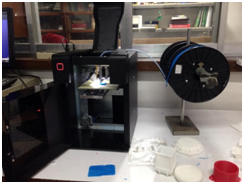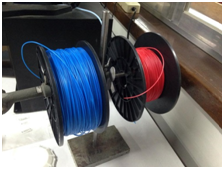Printing the World
3D PRINTING – also known as “additive manufacturing” is a relatively young field that has recently been making rounds in the news for its almost sci-fi applications. From little toys to babies’ organs, 3D printing is something everyone should have an inkling about.
What’s a 3D Printer?
Essentially, the parts of a 3D printer would be: 1) the print bed, 2) the printing instrument, and 3) the carriages and motors that will move the other parts. Some printers, like the printer in the ECCE Department’s, have these parts encased in a box.
How does it work?
What I found most interesting about 3D printing videos on YouTube was not how futuristic it looked; it was how straightforward and intuitive it seemed.
The process starts with a 3D model on your computer, stored in a .STL (STereoLithography) file. You can make one yourself using CAD – two freeware programs that can be used for this purpose would be Blender and Google Sketchup. Alternatively, you can download models of the objects to be printed online for free from websites like Thingiverse and Shapeways rather than making something from scratch.
After loading the model, it will be as simple as clicking on the “print” icon on the program. With this, the 3D printer will spring to life. Imagine that the 3D model will be horizontally cut into countless layers – like slicing an orange – and the printer will slowly “sculpt” the object layer upon layer. Whether the layer to be printed is of the actual paneling, overhangs, scaffoldings or support, the 3D model dictates how the 3D printer will go about printing the object. The mechanical movement of the printing instrument can be calibrated by the user to his/her whims, but every millimeter of movement it makes is pre-calculated by the computer beforehand.
Unbeknownst to many, there are actual many kinds of 3D printers, and “the printing instrument” shall depend as to which kind of printing method is to be used:
a) Deposition – this kind of 3D printer uses a nozzle that will apply the “ink,” which is usually a coil of plastic filament or metal. This works like a glue gun – the nozzle will be heated to 260°C, and the melted ABS plastic will be “glued” onto the print bed.
the ECCE Department of the Ateneo de Manila University, this is another form of 3D printing; but unlike the previous form, this will involve removing unnecessary parts rather than applying from scratch. Rather than a nozzle, drills will instead be used to chip away a block of raw materials.b) Milling – according to Sir Oppus, a professor from
c) Sintering – Selective laser sintering is the priciest among these three – a laser diode will be the printing instrument, and resin will be the raw material to be imprinted upon by the laser diode.
Sounds cool! What can you do with it?
- Prosthetic arm
- A Colorado 17-year-old high school student constructed a fully functional prosthetic arm and hand. To give you perspective as to how effective it was, Easton LaChappelle has already shown his invention to US President Barack Obama himself, and now works with NASA, according to thenextweb.com.
- Guitar
- With the fast pace of deforestation, eventually, guitars will need to be built from alternative materials. Bespoke Innovations, aside from being credited for creating the first 3D printed prosthetic leg, were also able to make the world’s first 3D printed guitar, made from plastic (for the guitar body) and steel (for the soundhole cover). Aside from saving the trees, imagine designing your own guitar!
- Baby heart model
- Using detailed MRIs, anatomically accurate replicas of the heart were printed in Peoria, and these helped doctors understand the defects of babies’ hearts; this ultimately helped the surgeons with their decision-making.
- Body cells and Body Parts
- A 22-year-old woman suffered a rare disorder where her skull would keep growing and growing. The solution was to transplant the top of her skull; amazingly, a specially crafted cranium made for the patient was 3D printed to be fit unto her skull. Today, she has fully recovered, is working, and is symptom-free.
- Bio-printing, anyone? It sounds like a sci-fi movie’s plot device, but it’s actually far from impossible. One example would be last March 2014, where scientists were able to print heart cells using a specially made hydrogel containing a protein called tropoelastin and etching it in such a way that heart cells aligned perfectly; due to this, scientists were able to grow a layer of human heart tissue that beat on its own.
- Scientists are considering the use of stem cells to row entire organs. Since stem cells are “young” cells, they can still develop into almost any type of cell.
- Last July 2014, a study was published in the journal of the Royal Society of Chemistry about a medical breakthrough for 3D printing body organs. Scientists were finally able to properly print the blood vessels – even the tiny capillaries where the exchange of nutrients take place.
- Houses
- WinSun Decoration Design Engineering, a Chinese company, produced ten single-story houses within a day, each costing only $5,000 to build. What’s amazing is that their “ink” for the giant 3D printer would be using glass fiber and construction waste. If this pushes through, then manpower costs and construction costs will be greatly reduced.
- Firearms
- 3D printed firearms used to be disposable, but a company called Defense Distributed has 3D models of various firearms online, downloadable for free. Imagine the possibilities – anyone with a 3D printer can make their own gun at home. This actually sparked quite a controversy in the US when the technology had just debuted, with the gun rights laws of the US.
From keychains to furniture, to houses and body organs, the world of 3D printing is young and it will keep on growing. The world’s cheapest 3D printer, the iBox Nano, was supported with much aplomb on Kickstarter and was successfully funded, reaching a little over $456,000. Although it can only print small keychains, tokens or toys, simply imagine – if a $300 3D printer will be arriving in store shelves soon, how much more will the world of 3D printing have to offer? We haven’t even touched the tip of the iceberg.
References and Additional Readings:
- Electronics Lab Profs!
- Carlos M. Oppus – assistant professor of the ECCE Department
- Juan Antonio J. Marinas – assistant instructor of the ECCE Department
- Prosthetic Arm: http://thenextweb.com/dd/2013/11/06/15-best-3d-printed-items-year/2/
- Cranium Replacement: http://3dprint.com/1795/22-year-old-receives-complete-3d-printed-cranium-replacement/
- Heart cells: http://www.3dprint.com/1676/3d-printing-patch-of-beating-heart-cells/
- Houses: http://www.archdaily.com/543518/chinese-company-showcases-ten-3d-printed-houses/
- Firearms, Guitar: http://www.hongkiat.com/blog/3d-printings/



Comments